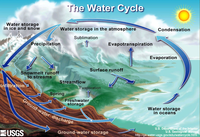Freshwater environmental quality parameters

Freshwater environmental quality parameters are like a big checklist that scientists use to see if a river, lake, or any other body of fresh water is healthy or not.
Think of it like checking in on a friend who isn't feeling well. You'd ask them if they have a fever, if their tummy hurts, if they're feeling tired, and other things to figure out what's wrong. Scientists do the same thing for freshwater bodies! They check certain things to make sure the water is clean and not hurting the plants and animals living in it.
Some of the things scientists check for include:
- Temperature: Like when you need to check if your bath water is too hot or too cold, scientists check to make sure the water temperature is just right for the plants and animals living in it.
- pH: This is like the water's mood. Some plants and animals like their water to be a little bit acidic (sour), while others need it to be more basic (bitter).
- Dissolved oxygen: Just like we need air to breathe, underwater animals need oxygen to breathe too! Scientists check how much oxygen is in the water to make sure fish and other aquatic creatures can breathe.
- Turbidity: This is like seeing how clear the water is. If it's too murky, sunlight can't reach the plants living at the bottom of the water, and they might not be able to grow.
- Nutrient levels: Just like how we need food to grow, plants in the water need nutrients like nitrogen and phosphorus to grow. But if there's too much of it in the water, it can cause "algae blooms" that can be harmful to fish and other animals living in the water.
By checking all of these different things in a freshwater body, scientists can tell if the water is healthy or not, and figure out how to keep it clean and healthy for all the plants and animals that depend on it!
Think of it like checking in on a friend who isn't feeling well. You'd ask them if they have a fever, if their tummy hurts, if they're feeling tired, and other things to figure out what's wrong. Scientists do the same thing for freshwater bodies! They check certain things to make sure the water is clean and not hurting the plants and animals living in it.
Some of the things scientists check for include:
- Temperature: Like when you need to check if your bath water is too hot or too cold, scientists check to make sure the water temperature is just right for the plants and animals living in it.
- pH: This is like the water's mood. Some plants and animals like their water to be a little bit acidic (sour), while others need it to be more basic (bitter).
- Dissolved oxygen: Just like we need air to breathe, underwater animals need oxygen to breathe too! Scientists check how much oxygen is in the water to make sure fish and other aquatic creatures can breathe.
- Turbidity: This is like seeing how clear the water is. If it's too murky, sunlight can't reach the plants living at the bottom of the water, and they might not be able to grow.
- Nutrient levels: Just like how we need food to grow, plants in the water need nutrients like nitrogen and phosphorus to grow. But if there's too much of it in the water, it can cause "algae blooms" that can be harmful to fish and other animals living in the water.
By checking all of these different things in a freshwater body, scientists can tell if the water is healthy or not, and figure out how to keep it clean and healthy for all the plants and animals that depend on it!
Related topics others have asked about:
